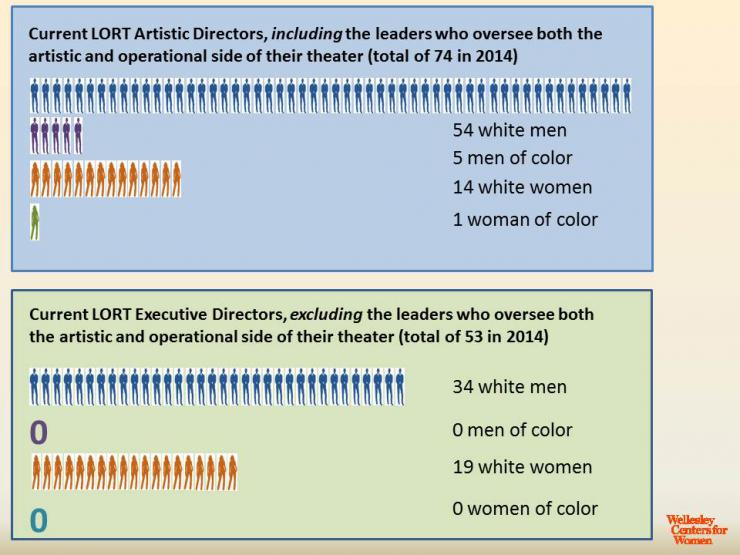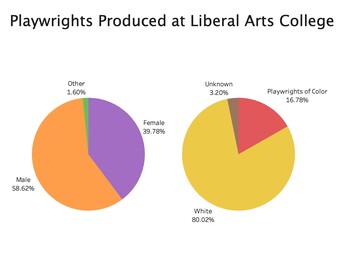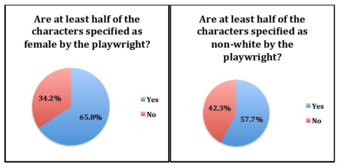Why Are There So Few Women Leading Theatres and What Can Be Done About It?
This week on HowlRound, we continue the conversation on gender parity, which has been gaining momentum this year through studies, articles, forums, one-on-one discussions, and seasons and festivals focused on women. As Co-President of the Women in the Arts & Media Coalition and VP of Programming for the League of Professional Theatre Women, I have the pleasure of working with, coordinating, contributing to, and raising awareness about many of these local, national, and international efforts. This series explores what needs to happen right now—in this precipitous moment—in order to profoundly, permanently expand the theatrical community's views and visions of women, both onstage and in every aspect of production.—Shellen Lubin
When people unfamiliar with the world of theatre learn that our current research is on why there are too few women leading major US theatres, their first comment is, “But it’s better than it used to be, right?” We say, “No, the situation hasn’t changed for decades.” They respond with, “I don’t understand, look at Lynne Meadow, look at Diane Paulus.” We say, “Yes, there are a few illustrious examples.” Unfortunately, comparisons with the “bad-old-days” and mention of token successes also showed up frequently in our interviews with 100 theatre professionals. Furthermore, they added, “Racial minorities have it worse, that’s where we should focus our attention to diversify leadership.”
In 2013, the leadership of the American Conservatory Theater in San Francisco approached us at the Wellesley Centers for Women to be their research partner for studying gender equity in League of Resident Theatres (LORT) leadership. There were only fifteen women who served as artistic directors, or held the combined Artistic Director/CEO position in the seventy-four LORT theatres at the time. The situation on the executive/managerial side of the theatres was better, but not much: there were nineteen female leaders. There was only one female artistic director of color. For men of color, leadership representation was also bleak: there were five leaders on the artistic side, and like women of color, none were top executive/managerial leaders. Our research, which is supported by the Virginia B. Toulmin Foundation, the Valentine Foundation, and individual donors, suggests that many issues associated with the scarcity of women in top leadership are also true of people of color. Pointing to the scarcity of people of color to avoid paying attention to women is an excuse. There needs to be action on both fronts, paying particular attention to the virtual absence of women of color in theatre leadership.
Our research strategy aimed at better understanding the career paths of those in current leadership in order to make recommendations for aspiring future leaders in the pipeline and examining the search process to make recommendations to hiring committees. We had two informant pools: our primary charge was within LORT, so we focused on current leaders and their immediate reports within the League through interviews and resume analyses. Because candidates for leadership can come from both inside and outside of LORT, we also gathered anonymous survey data from stage director members of SDC and operational managers in TCG theatre members with a budget of over $1 million.

Pointing to the scarcity of people of color to avoid paying attention to women is an excuse. There needs to be action on both fronts, paying particular attention to the virtual absence of women of color in theatre leadership.
First, we studied the pipeline. The career path toward an artistic director (AD) position is strongly defined by “whom you play in the sandbox with,” in the words of one of our interviewees. The skills of directing and producing can best be honed by getting invitations from multiple theatres to bring a variety of plays to the stage. But skills are not enough. To have a shot at top leadership, directors and producers need to build relationships with people who can speak to their strengths and can vet their reputation. In our survey with almost 1,000 stage directors, women highlighted two barriers toward succeeding in their quest to become the artistic leader of a theatre: a lack of opportunities to direct widely to strengthen their portfolio, and not having someone speaking to their strengths. Stage directors of color (both women and men) added to these two barriers faced by white women that they also confronted being pigeonholed into directing plays by playwrights of color.
So, yes, there is a pipeline issue facing women and people of color in their preparation for artistic leadership. How do we strengthen the pipeline?
- Make conscious, planned, and thoughtful decisions to include women and people of color as directors and producers in programming each and every season to provide them with frequent, varied opportunities.
- Travel and relocation are real obstacles for both men and women with families, but the preconceived notion that “they won’t want to come and do this” is a stronger barrier for women. If these issues do present a challenge, be willing to accommodate the director’s needs.
- ADs should invite directors of color to direct the classics as well as new plays to support their portfolio growth.
A word of caution: To conclude that the main problem is a pipeline issue and over time more women and people of color will become viable candidates is an incomplete diagnosis of the problem, and an excuse. It dismisses the large numbers of producers and directors who are well prepared and eager to take on artistic director positions. In addition to the pipeline, there is just as profound a glass ceiling that can be broken with a change in mindset among those who make hiring decisions. Here are some action points for hiring committees about selecting ADs:
- Don’t overlook the sizable number of women directors and producers, including women of color, who have founded theatre companies, and have developed expertise in all aspects of artistic leadership. These women constitute a viable, immediately available pool of candidates, but are being overlooked in searches and are waiting just below the glass ceiling. Curiously, we found previous AD experience to be prevalent in the background of male, but not female artistic directors within LORT.
- Be willing to go beyond your comfort zone and the current model of the male leader to trust and select women (and people of color) candidates. A fair number of female LORT ADs had worked in a LORT theatre prior to their AD appointment. These women were known and trusted, hence were promoted. There are many other talented women (directors and creative producers) who have the necessary skills without having worked in LORT. They need to be pulled into the search process.
- Learn how to and then actively support any candidate’s success once on the job and continue to mentor them. One AD of color we interviewed points out that gender should hardly matter in choosing a candidate: “... nobody is prepared for one of these jobs when they come into it.” All new hires, male or female, people of color or white, will need support from their Board to succeed.
- Move toward developing metrics for vetting leadership candidates to create greater transparency in the selection process and provide guidance to people in the pipeline. These metrics can also be used to evaluate the wisdom of the board’s selection and the performance of the candidate chosen.
Women have fared slightly better on the operational side of LORT theatres, outnumbering men in all departments, except executive/managerial directors (ED). So there is no pipeline problem for ED appointments; the absence of women at the top is clearly a glass ceiling issue. All it will take is for search committees to have the resolve to move beyond the model of having a man as the operational leader. But the lack of a pipeline issue for women aspiring to become EDs is true only for white women. Women of color are far fewer on the operational side and there is no woman of color who is the ED of a LORT theatre. For women of color, there is both a pipeline and a glass ceiling issue preventing their presence at the top. In our surveys, both women of color and white women’s comfort and expertise with fundraising come through as their strongest assets, and should be reasons for Board selection committees to seek them out. Indeed, a background in development is well represented among white female EDs. However, women managers reported that they are just as comfortable with budgeting, contracts, or real estate law. Ignoring these talents by placing the majority of women in development is limiting the pipeline and solidifying stereotypes that general management and finance are male domains.
Breaking the glass ceiling by creating more opportunities for women and people of color among current leadership in LORT now, without further delay, will serve as a route to simultaneously grow the pipeline reaching all the way down to high school teens who will learn to see the theatre as a possible and viable option among their career choices.
To find out more information about the Women’s Leadership in Residential Theaters project, click here.














Comments
The article is just the start of the conversation—we want to know what you think about this subject, too! HowlRound is a space for knowledge-sharing, and we welcome spirited, thoughtful, and on-topic dialogue. Find our full comments policy here
When I look around, what I often see is a male AD and an female Associate AD...and she's often doing a *lot* of the work...
The University Resident Theatre Association launched our Arts Leadership Initiative this year with this very issue in mind. So far we have seen more than a 150% increase in Theatre Management applications to our national unified interviews (where candidates interview with potential MFA programs). More than half are women, and half are people of color.
We're hopeful that this program's success will enable us to expand it next year, and ultimately play a part in enriching and diversifying the pool of candidates for jobs in arts administration & management.
I'm curious to know how the choice of hiring an AD is affected by the demographics of the board of directors, and by their perception of the AD as a successful fund raiser. Is it a question of connections, within the world of donors, and/or trust, in their ability to fund raise? Gender/race parity among CEOs and wealthy donors is hugely skewed. Since one of the primary jobs of an AD is fund raising, perhaps this too should be considered.
Fundraising is an important issue, thank you for raising it. We looked at the fundraising function of the Artistic Directors from several angles: We asked about it in interviews with LORT ADs and also collected survey data on this topic from stage directors across the country (about 1,000 of them). Interviews with LORT ADs reinforced the idea that the primary responsibility of ADs is to develop a vision for their theater and to articulate that vision. ADs serve as the
public face of the theater but their responsibility for fundraising is primarily exercised through public speaking and personal relationship skills in meetings with donor audiences.
The results of the survey with a large group of stage directors that went beyond the 74 LORT theaters also showed that fundraising experience was NOT a key qualification. In fact, among 40 possible skills/qualifications that we asked Artistic Directors in the survey to rank in terms of how much credit this skill got for an appointment to an AD position, fundraising fell in the lower half.
However, a lack of sufficient fundraising experience was reported as the number one reason for not succeeding in getting an AD appointment among both men and women who had applied for such a position. For both gender groups, the lack of fundraising experience got about 20% more votes than the runner-up skill, which was “not enough experience producing shows.”
This seems to be contradictory: one group thinks lacking fundraising experience is why they fail, while the group who has succeeded in becoming an AD, does not credit this same skill for their attained success.
It seems to us that the fundraising skill for an AD is better thought of as a skill in articulating the theater’s vision to many different audiences and a willingness to bring this articulation to cultivation events. This seems to also be something important for Boards of Trustees to understand, especially those on search committees. Here’s why: An artistic director is indeed the spokesperson for a theater, but actual fundraising is done on the operational side of a theater by the development office, and overseen by the ED or MD or GM, etc. During a search, an artistic director candidate will be asked to review a theater’s past programming and articulate a vision of how they would approach putting it together going forward. Being able to articulate a vision for the Board’s hiring committee and inspire them with it, is a crucial element in hiring decisions. Once that spark has been lit, the fundraising will be an operational translation of that articulated vision. If Boards correctly understand the necessity of that articulation and cultivation skills, they will see that women actually fare well: Many female ADs we surveyed had been founders of their own theater. What better way for an artistic director to understand and get experience with how to articulate a vision and, simultaneously, cultivate
audiences/donors and getting them on board with a new theater’s mission? On the operational side, women often run the development office; this experience should make them ideal candidates for operational leadership.
So, to address your specific questions: Trust is indeed everything. The demographics of the Boards may not matter; in fact, most theater boards are gender balanced. What will matter is for a Board to see the strength of a candidate’s audience cultivation and to trust the strong link
between that skill and success in supporting the theater’s fundraising activities. And, those who are preparing for a leadership role should focus their attention on cultivating the art of articulating a theater’s mission, public speaking, and interpersonal relationships.
Thank you for doing (and sharing) this important work!
I'm curious about the parallels between the absence of women in leadership positions in LORT theaters (and other artistic organization, like museums) and the absence of women in C-Suite positions in the corporate world. (The McKinsey/LeanIn study "Women in the Workplace" has easily accessible stats: http://womenintheworkplace..... The numbers are quite similar. Interestingly enough, the numbers are also similar to our representation of women in government; 20% women in Congress.
Of course we must focus on the area in which we, as individuals, work--and here that is theater-- but having conversations about the trends, statistics and possible solutions in theater seems quite incomplete without including the trends, statistics and possible solutions in our broader culture. This is not to say you should have touched on these things in the study or even this article, but rather that our community needs to have a larger conversation now that we have this data.
One of the challenges is that in many instances there is no search committee. The job of searching for those top positions at a LORT level are often given to head hunters and/or firms that provide search services. Sadly these firms overlook most if not all of the things that your work has found.
Thank you for doing the work and putting this information out in the theatre community!